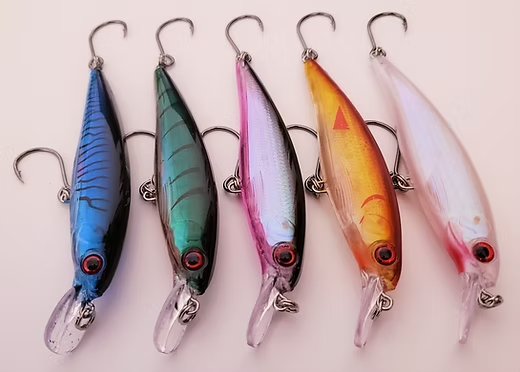Jerkbaits are one of the most effective lures for targeting aggressive predators like bass, pike, and walleye ,especially when fish are suspended or sluggish. But to truly unlock their potential, you need to know how to fish them correctly.
In this guide, we’ll share 10 essential tips when using jerkbait for fishing from cadence and gear to seasonal tactics. Whether you’re a beginner or seasoned angler, these techniques will help you trigger more strikes and land more fish.

1. Understand What Makes Jerkbaits Unique
Jerkbaits are long, slender lures that imitate injured baitfish. Their erratic side-to-side darting motion is triggered by sharp twitches of the rod, making them ideal for provoking reaction strikes.
There are two main types:
- Suspending jerkbaits (stay in the strike zone)
- Floating jerkbaits (rise when paused)
2. Use the Right Rod & Reel Combo
A 6’6” to 7’ medium or medium-light rod with a fast action tip gives you the snap needed to work jerkbaits effectively. Pair it with a high-speed baitcasting or spinning reel (6.3:1 or higher) for quick slack pickup after jerks.
3. Choose the Right Line
- Fluorocarbon (10–12 lb test): Sinks slowly, stays invisible, and keeps the bait at depth.
- Monofilament (10–15 lb): More buoyant, great for shallower presentations.
Avoid braid unless using a leader—it lacks stretch and may reduce natural action.
4. Master the “Jerk-Pause” Cadence
The magic of jerkbaits lies in the pause. The pause is when most strikes happen.
Try this cadence:
- Jerk-jerk-pause
- Jerk-pause
- Jerk-jerk-jerk-pause
Change the rhythm based on how the fish are reacting—cold water often calls for longer pauses, while warmer water allows for a faster cadence.
5. Watch Your Line on the Pause
Since bites often occur when the bait is motionless, your only indicator may be a twitch in the line. Stay alert and be ready to set the hook quickly.
6. Match the Hatch With Size and Color
- Size: Use smaller jerkbaits (3-4 inches) in clear water or for pressured fish. Go larger (5-6 inches) for big bass or murky water.
- Color: Stick with natural colors (silver, ghost shad, perch) in clear water and bright or opaque hues (chartreuse, clown, bone) in stained conditions.
7. Use Jerkbaits Year-Round
While they shine in cold water (late fall through spring), jerkbaits are effective year-round. In summer, target suspended bass over deep structure. In winter, slow down with long pauses (5–15 seconds).
8. Vary Your Retrieve Based on Water Temp
- Cold (under 50°F): Slow jerks, long pauses (up to 10 seconds)
- Moderate (50–65°F): Medium cadence, 1–3 second pauses
- Warm (65°F+): Fast snaps, short pauses or steady retrieve
9. Don’t Overwork the Bait
New anglers often over-jerk the lure. Keep it subtle—short, sharp twitches are more effective than aggressive rod sweeps. Let the bait do the work.
10. Keep Extra Hooks Sharp and Ready
Jerkbaits often have treble hooks, which can dull or bend easily. Swap out stock hooks with high-quality trebles like Gamakatsu or Owner, and sharpen regularly to prevent missed hookups.
Conclusion
Jerkbaits are a deadly tool when fished with the right approach. By understanding cadence, gear setup, and seasonal behavior, you can consistently trigger reaction bites and increase your catch rate.
Top Takeaways:
- Use fluoro line and fast-action rods for better control
- Adjust your jerk-pause cadence to match water temp
- Pay close attention to your line during the pause
- Always match size and color to local forage
Whether you’re chasing bass in spring or triggering strikes in cold winter water, jerkbaits deserve a permanent spot in your tackle box.

